Leyneuf Tines has officially joined the Modern Moves research team as our PhD student. She will work on histories of Afro-diasporic rhythm and movement and their relationship to textual accounts of Haiti. Welcome to the team!
All posts by mm_admin
Helena Metslang, Modern Moves Administrator: My first impressions in the world of dance

Six months ago, I started my new job at King’s College London, where one of my major duties is administration of the everyday life of Modern Moves. Being trained as a linguist and having no background in dance at all— little did I know back then what I was immersing myself in with this administrator job. Here, I will tell you a little more about my impressions and the people I have met along the way.
After our first research seminar event I already found myself in a noisy dance club bravely taking my first salsa steps in dancing amongst my new colleagues. Since then many more aspects of the versatility of the big world of African (influenced) dance have revealed themselves to me. I have discovered new clubs (I would definitely recommend Shaka Zulu to anyone who hasn’t been!), dance studios (I especially like Iris de Brito’s classes where you get to practice African ways of movement in light-hearted, humorous, and sometimes quite silly ways until everyone is just laughing together), DJs, dance stars and even experts of fabulousness and “fierceness” in the performing arts. A peek into the dance world has opened the door to some colourful, joyful and light-hearted ways of being.
Sinful pleasures vs. innocent pleasures
Some people say that there are three kinds of pleasure in the world: pleasures that are either damaging to your health, make you fat or are offensive to someone. Often times it proves to be true, be it a pub crawl or indulging in chocolate cakes. I have been quite impressed seeing dance people being an exception and turning this common wisdom around. It is fantastic to observe how the joy of simple things, just the pleasure of being human, and moving your body can take the place of all sinful pleasures!- be it tapping out the rhythm of merengue with your fork, knife, glass and palms, or making some unexpected African dance jumps with your colleagues.
Mysterious sexuality
One good aspect I have noticed about Modern Moves research is that it brings together these charismatic, colourful, strong and funny researchers, dancers, DJs, musicians, choreographers and other show people from all over the world. What contrasts one gets to see in the process! You get practitioners from the more authentic, traditional African dance and then from the newest trends of social dance floors or salsa congresses.
Sexuality is an interesting topic in relation to this. I’m gradually starting to get the picture of the tricky role this theme plays in our research project… One day you go to the workshop where you deal with healing your soul with this pure joy of movement. It takes you to the basics of West African dance by liberating you from tensions caused by social restrictions and sexuality related expectations and norms. I love it that the teacher who is also the creator of this dance form has purposefully stripped the dance of sexual energy to use its healing power in other ways. Another time we have a meeting with a DJ of salsa congresses. He on the other hand tells us extensively and compellingly (by using quite spicy vocabulary aided by visual gestures!) of his fantastic theories of sexuality. These are of course based on his everyday observations of highly sexually charged scenes on club dancefloors. This is thrilling and you just enjoy being carried along by his captivating story telling manner.
Feminism and dancing divas
An equally interesting phenomenon concerns the women you meet in the world of dance and dance research. Again, they can represent quite extreme opposites, different ends of the spectrum. Some dance researchers have quite strongly established feminist views. They like to think about the question of who is taking the lead in the couple dance and how it is done– either by her (!) or him. They enjoy discussing and thinking how feminist ideas go with this phenomenon.
On the other hand there are these female partners of star dancers who enjoy their diva role and don’t also mind dancing these dances that culminate with moments where the male partner repeatedly slaps the woman’s derriere.
It is exciting how female dancers (including several dancer-researchers that you meet) seem to feel extremely confident in their bodies. Some of them don’t bother much with make-up, dressing femininely or even sitting femininely with knees together as our mothers taught us to do – their beauty just beams out of them nevertheless.
They are also not embarrassed to sometimes take the pupil role. They feel confident enough to demonstrate quite private videos to the seminar audience of them taking first steps of the dance among the Angolan youths in the local fab party. (Gosh, this was an amazing party video, with the MC energetically pacing on some roof back and forward in the dark Angolan night with white leather trousers and some yellow never-seen-before-mad-African-fashion jacket). The whole seminar was a great laugh indeed. I am ever thankful to the presenter for teaching us the lesson that you can have loads of fun even if your skills are not that spectacular in the beginning. (I remember when a long time ago I was in an African night club in Ghana for the first time, I was just standing stunned looking at their dance, the fast jumps and the rapid movements of their dignified round posteriors! I was wondering to myself then that probably white people would not be able to reproduce something like that but obviously I was wrong!)
Workwear of carnival research
The last thing to mention is the working apparel of the practitioners of this field. You might think of workwear shops where doctors, construction workers, etc. buy their working clothes and protection tools. In our project these requirements are quite different. When Ananya went to her fieldwork trip to the Rio carnival, she packed her suitcase with feathers and grass skirts (haha, unfortunately our funding contract doesn’t cover these project expenses at the moment). The protective accessories given to you when you buy a carnival pass that are necessary for the young and careless participants of the Rio carnival are also quite different from one’s usual expectations. This will be a little surprise for the project auditors once they start looking at our folders containing material evidence of the project activities. Let this be our little secret at the moment… 🙂
Malambito Dance – Champeta from Colombia. Chosen by Leyneuf Tines
Mambo Italiano meets Paris Noir
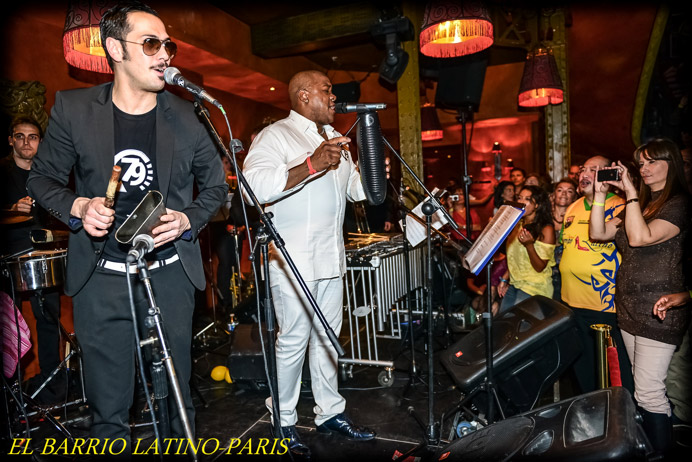
One of the most popular songs of the 1950s celebrated the ‘mixed up Siciliano’ who abandoned his native tarantella to ‘learn-a how to mambo’. Dance and style evolve together: even the mozzarella was being forsaken for enchiladas. The result was a fusion of worlds: ‘Mambo Italiano’, as the song’s chorus triumphantly declared. In recent years, ‘Mambo Italiano’ has been reborn: Italy is enjoying a salsa boom, with Milan at the centre of this development.
The new Mambo Italiano exemplifies the history of Afro-Latin dance as one of rebirth and repetition. In the 1940s, ‘mambo’ was the dance style that emerged alongside a new kind of music created by Cuban composers such as Perez Prado. This mambo transmitted the inexplicable exhilarations of modernity. As Celia Cruz sang, ‘mambo es electricidad’ (mambo is electricity). In the 1960s, ‘mambo’ re-emerged in New York as a new way of dancing to Latin music. Repackaged as ‘salsa’, this music still drew on the rhythms of pre-revolution Cuba, which in turn had drawn on the percussive traditions of African slaves on sugar plantations.
Mambo as the New York style of dancing salsa (also called On2) now has a new home in North Italy. Dance schools such as Tropical Gem are legendary in the salsa world for their flair and precision; moreover, the fastest, sharpest and most stylish dancers from Latin America– Juan Matos (from the Dominican Republic), Maykel Fonts (from Cuba- note that he represents the Cuban dance style), and Adolfo Indacochea (from Peru)- have made their home in Milan, while Parma nourishes the talented Italian all male Grupo Alafia. Milan also hosts several international dance festivals dedicated to New York style salsa. Mambo Italiano is once again the rage.
In step with the dance’s popularity, several Italian salsa bands have emerged. Of these, Maxima 79 is the latest and the most successful. Its leader and songwriter Fabrizio Zoro acknowledges salsa’s complex transnational history as his own musical inheritance. ‘Cuban music before the revolution had a lot of influence on the music of New York which at that time included several rhythms such as the cha cha cha, the pilon, the Mozambique, the boogaloo, and the shing-a-ling… The guaganco of the 70s created by Fania [the Latin music conglomerate] was nothing more than the Cuban music of the 40s of Beny Moré, Arsenio Rodriguez, Cachao, Inazio Pineiro, Perez Prado and Xavier Cougat…’
Fabrizio’s musical imagination is fed by two sources: the fertile formative moment of 1940s Cuba, and 1970s New York as a crucible for creative recycling. The Nuyoricans ‘merely improved on a sound that existed earlier but was no longer heard because of the sanctions on Cuba, which, in Cuba, also influenced the way music changed to timba. Many songs of the 70s are covers of the 40s’. From Cuban music to Dominican bachata and salsa brava/ salsa dura (‘strong/ hard salsa’- the music that developed in New York between the late 1960s and the early 1980s), Fabrizio’s historical consciousness combines with a passion for it all. ‘I love to mix it all up.’
As one of Europe’s most successful Latin DJs, Fabrizio certainly mixes it up on the dance floor at salsa festivals, ensuring that people keep moving till the dawn breaks. Not one to rest on his laurels, he found himself wondering, ‘is it possible to make an album of contemporary salsa with the older sound? Why isn’t anyone doing this?’ Taking up this challenge, he and his friend Massimo Scalici began creating songs under the band name of La Maxima 79 (1979 being the year of Fabrizio’s birth as well part of the decade that gave birth to the salsa he recreates). ‘I wanted to show the world that today one can indeed create a modern salsa album with arrangements and a sound that is typical of yesterday.’
The result is the incredibly successful album Regresando al Guagancò, released last year, although individual songs have been appearing as singles since 2010. As a salsa dancer, I have been part of dance floors going mad for these songs; as a listener, I have been equally engaged by the album’s thematic coherence, historical awareness, percussive energies, and sonic richness. The title, ‘return to the guangancò’ is suggestive: it signals Fabrizio’s desire to return to the musical sounds and arrangements of the 1970s- a project created by ‘a DJ like myself, who for twelve years has been observing what dancers need to be able to dance at their best- with a lot of breaks through which to interpret the music.’ But the ‘guangancò’ he gestures towards is not only its 1970s avatar: it is also the ‘son guaguancò’- ‘a style born with the music of the blind genius, the Cuban Arsenio Rodrigues’- the first to update for modern bands the harmonies of the older plantation genre, the guagancò.
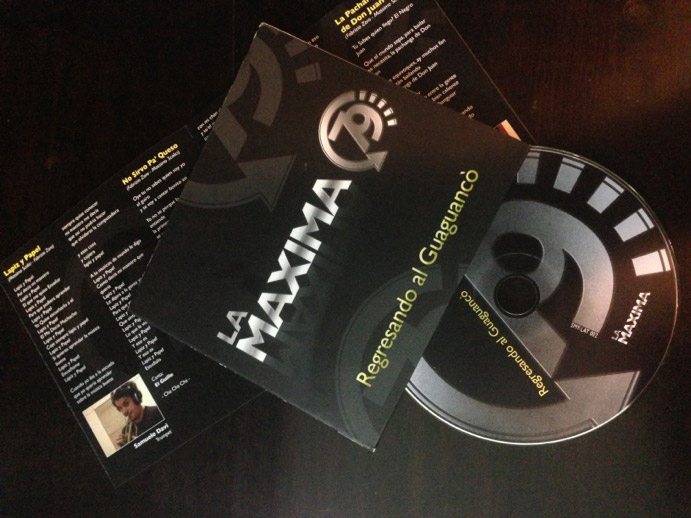
‘An old sound that the dancers of today are always seeking more of’ says Fabrizio of his album- which to drive its point home, even includes two versions of its most popular songs, ‘Pobrecita’ and ‘El Trigueño Cintura’ in ‘old vinyl sound’: the massively favourable reception enjoyed by this album testifies to the paradoxes of the salsa dance floor today. Fully transnationalised, with dancers often travelling every weekend to salsa festivals across the world, there is a deep hunger nevertheless to return to the iconic moments of 1970s New York, to the communities of ‘el barrio’ (the neighbourhood) and ‘la calle’ (the street). Reviving the dance styles of that moment becomes a way to perpetuate and participate in an archive of the body. To consciously create what Fabrizio calls ‘a new album that nevertheless turns back’ is the logical next step.
Replete with tasty cha cha chas, charangas, mambos and guagancòs, nearly all written by Fabrizio and arranged by him and Massimo, the album blurs the distinction between yesterday and now in a manner that replicates the time-dissolving experiences of the dancefloor. This dedicated recreation of a past authenticity makes possible another impossible dream- dancing retro music to a live band that is nevertheless producing original sounds. To experience this ‘Salsagesamtkunstwerk’, I made a pilgrimage to that other shrine of Afro-Latin dance, the Barrio Latino club just off the Bastille in Paris. This beautiful edifice, constructed by none other than Gustave Eiffel, has been hosting salsa and other Latin dance events for the past decade, and it was to celebrate its tenth anniversary that La Maxima 79 were playing there on the 23rd of March this year.
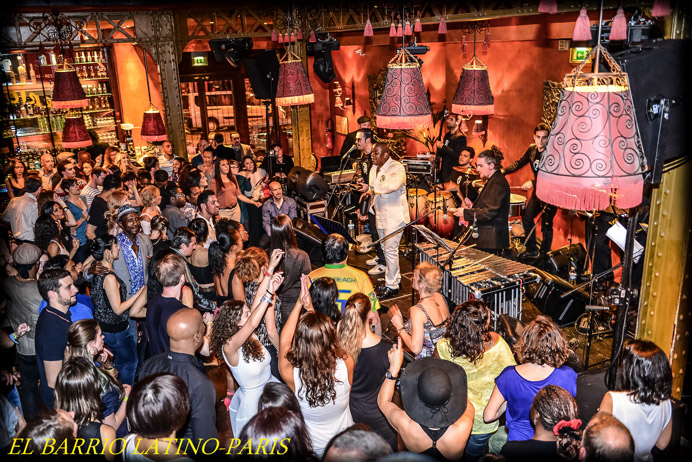
Barrio Latino: a baroque venue which, in its ability to unite, week after week, the highest level of dancers in search of the perfect synthesis of music, movement and style, remains unsurpassed anywhere in the world. The Barrio has always been for me a temple of salsa. I have been drawn to it ever since I first began dancing, and I have literally cut my dancing teeth on its floor. I continue to be struck by this venue’s capacity to support and nourish a dancing crowd that has no historical connection with the world of Spanish colonialism, which produced the musical and kinetic amalgam leading ultimately to ‘salsa’.
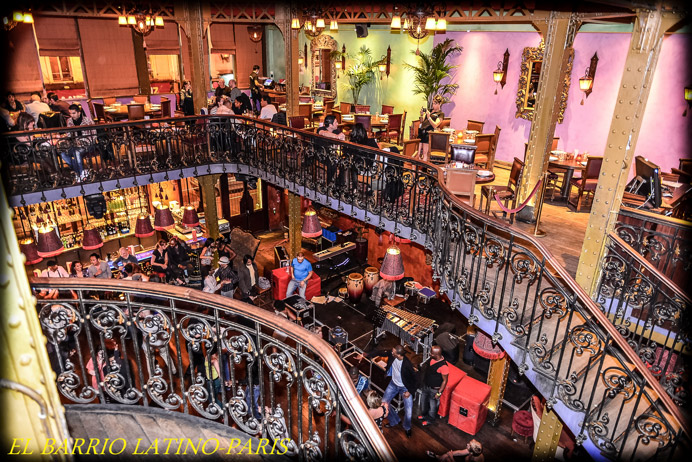
Here, dancers from Francophone Africa and the French Caribbean (including several who reveal themselves as of Indo-Caribbean heritage) have their own rhythm (his)stories- and yet they have found in salsa, a style from Latin America, a mode of self-expression and self-fashioning. And at La Maxima’s concert, they were moving to the rhythms of an Italian band whose members ware singing and addressing the crowd in the ‘lingua franca’ of Spanish. This was a fully creolized atmosphere, where ‘creolization’ surpassed the conventional understanding of the term as a new world mixture of European and African— on stage at a certain moment were Italians from Sicily and Lombardy, an elite dancer from Senegal, and the organisers of Barrio’s dance events of North African and Indo-Caribbean lineage respectively (not to forget the researcher-participant from India observing from the floor).
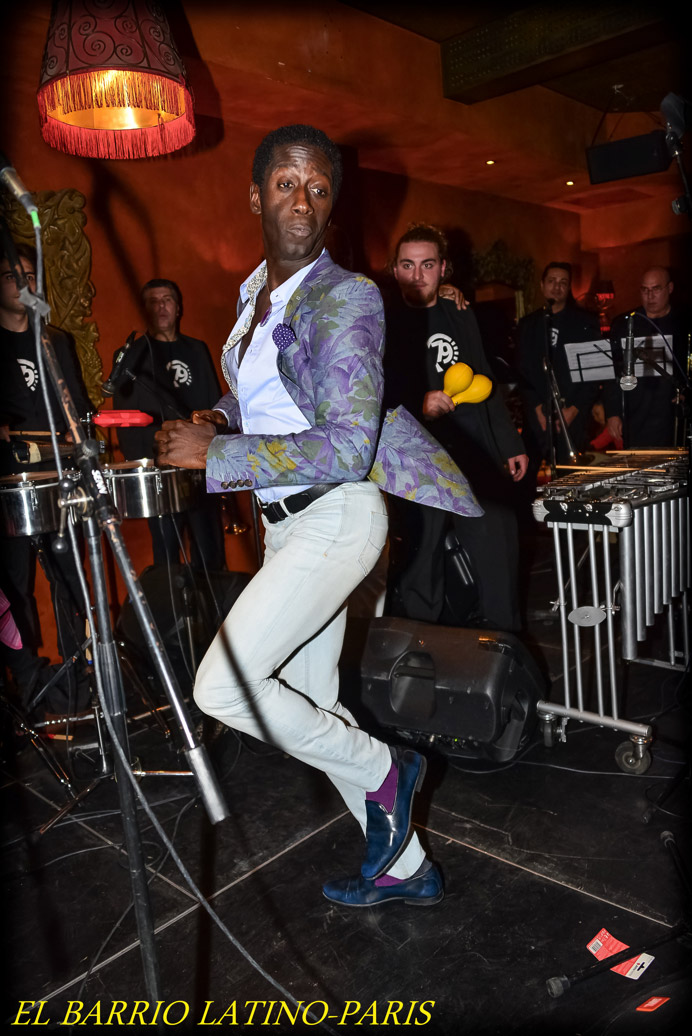
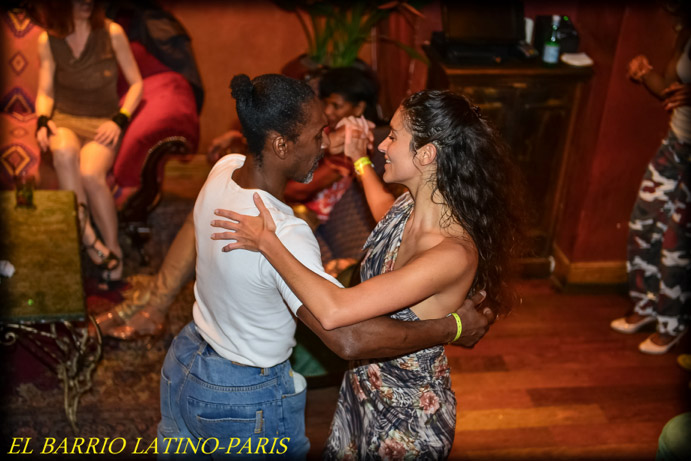
This kind of atmosphere redirects questions about authenticity to issues around the production and circulation of happiness. The desire for authenticity can then be seen as a necessary step towards a historically conscious mode of collective enjoyment. Thus central to the band’s self-projection was the oscillation between their pan-Italian derivation and their lone Cuban member, the singer El Guille, who was asserted to be the ‘soul’ of the band. The need to acknowledge the foundational role of Cuba as the cradle of Afro-Latin sound and spirituality manifests itself in the album’s song ‘Descarga Chango’, a jam session dedicated to Chango/ Santa Barbara, one of the most important Afro-Cuban deities, even as other songs such as ‘Singapore Vibes’ take us on journeys that overlay the older sea routes with the tracks of the jet engine.
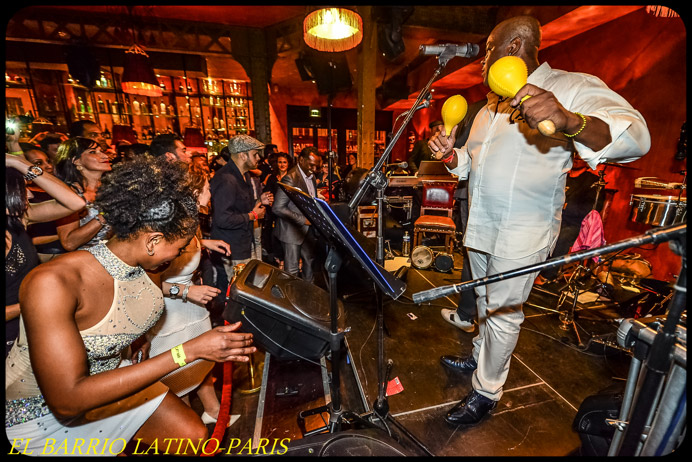
As several songs on the album demonstrate, though, Fabrizio created through them a tapestry that weaves together his personal history and that of the music and dance. There are songs dedicated to his late mother (‘Esa Mujer’), to his ex-girlfriend (‘Pobrecita’), http://www.youtube.com/watch?v=NOrfzcA6jzI, to his musical guru (‘Lapiz y Papel’), to his own discovery of salsa brava through the music of Ray Perez (‘El Trigueño Cintura’), and to master reviver of the dance style, the pachanga, his fellow Milanese Juan Matos (‘la Pachanga de Don Juan’). Some songs, such as ‘Habia Cavour’ http://www.youtube.com/watch?v=1fAWJn7NB0I demonstrate a sublime intertwining of Italian and pan-Latin elements: it describes (verbally and musically) the joys of the cha cha cha alongside the mysterious yet unmistakably Italian refrain ‘Habia Cavour’ (there used to be Cavour), which turns out to be a verbal play on the studio where this album was made, on Milan’s Via Cavour (‘a Via Cavour/ ‘On Via Cavour’).
The most lovable of these Italian-Latino conjunctions is the song ‘No Sirvo Pa’ Queso’ (I’m not used for cheese’) http://www.youtube.com/watch?v=mBvxbjKMbkw, which describes that most ubiquitous yet potentially overlooked instrument- the guiro or scraper. Sung in the voice of the guiro, the lyrics remind us of the crucial importance of this member of the so-called group of ‘minor percussion instruments’. The chorus asserts, accordingly, that although the whole world may think so, it (the guiro) is not used for cheese- and goes on to add variations on what it actually does to the music: ‘I bring flavor and energy to the guagancò’. Dare we surmise that this totally apt comparison of a scraper to a cheese grater could only have emerged from the imagination of an Italian from Lombardy, one of the provinces that produce Parmesan cheese? As Fabrizio confirms, ‘I wrote it because I always take my guiro to my DJ sessions, and earlier people used to ask, is that a cheese grater?’
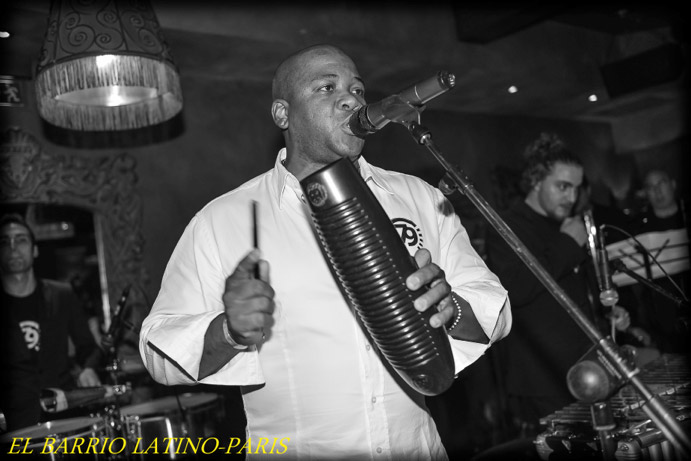
The Italian flavour that La Maxima 79 bring to salsa brava is all the more charming for its subtle harmonizing with the rich transnational history that is already folded into the sounds, beats and movements of what we today call salsa. Always reflecting the flow of people dictated by the grand currents of world history, the music continues to draw on new migratory patterns in the post-Cold War Era. As Fabrizio reminds us, ‘there are also many Cubans in Italy from who we have learnt a lot about Caribbean music, making a wonderful connection between Cuban culture and Italian melodies, and Italy is the homeland of melodious music that belongs to the world.’ And as he reminded the audience at Barrio Latino, ‘without music there are no dancers’.
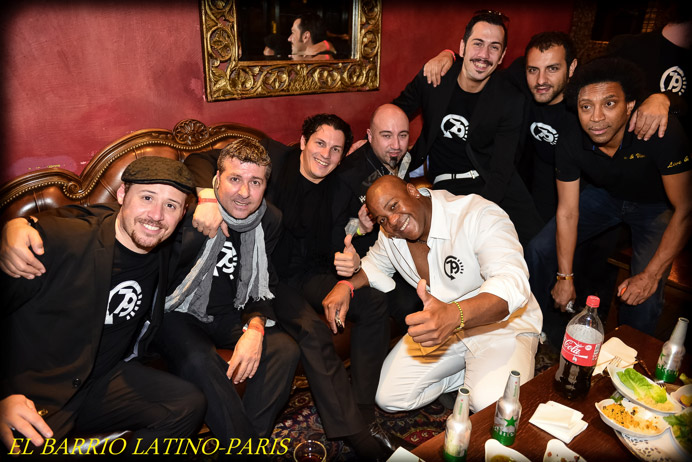
Indeed the story of La Maxima 79’s creation, inspiration and success confirms yet again that Afro-diasporic music and dance moves in surprising ways across the world and under conditions that are completely unpredictable from the perspective of language-based connections between former imperial centres and erstwhile colonies. A Cuban singer paying homage to Chango through songs written by an Italian songwriter, an Italian songwriter paying homage to a Dominican dancer living in Milan who pays homage to a dance style of 1960s New York; a packed dance floor in Paris where dancers from different parts of the Francophone sing with and move to an Italian band singing in Spanish, with the event taking place in a building redolent of Parisian modernism… Through the power of kinetic nostalgia and the pull of the beat, this particular return to the guagancò sounds out the measures of modernity and the continuing potential of rhythm to change the script in a predictable world.
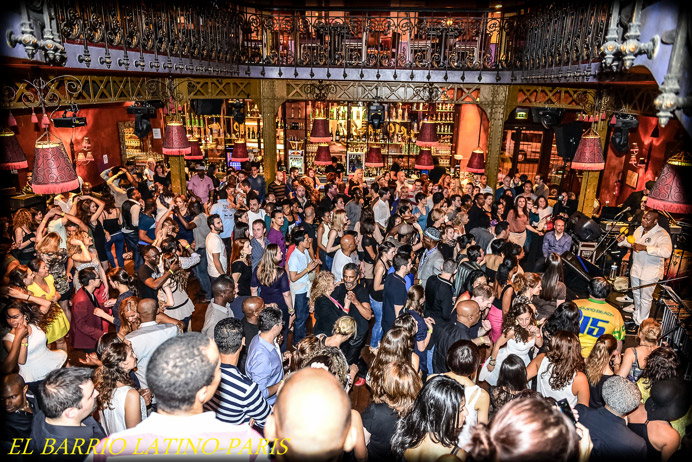
This Moving Story is based primarily on Ananya Kabir’s interview with Fabrizio Zoro, and her experiences of dancing to La Maxima’s music at salsa festivals, salsa parties and en vivo in Paris. All the quotes used within the article are taken from an e-interview with Fabrizio Zoro (13th- 17th April, 2014) and translated from the original Spanish by her.
All photographs used here are by Franck Billaux, Mundo Afro-Latino, Normandy (CHECK), except where specified. Merci, Franck!
We are extremely grateful to Fabrizio Zoro for the precious gifts of his time, music, CD, and words!- and to Wilfrid Vertueux, aka DJ Willy the Viper and Simy Materazzi for facilitating the connection between Fabrizio and Modern Moves. Merci beaucoup/ muchas gracias/ grazie mille!
Our website is launched!
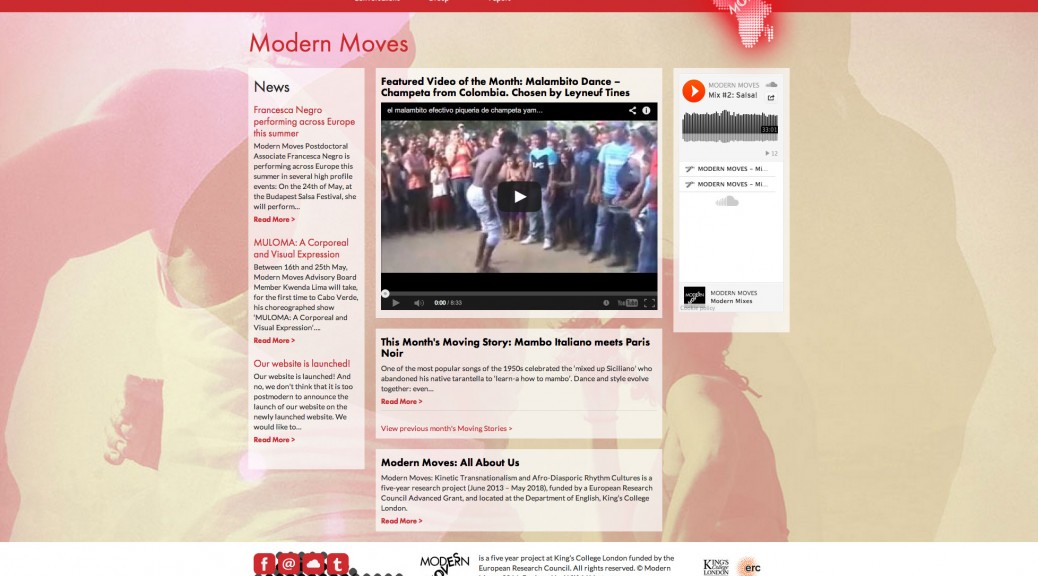
Our website is launched! And no, we don’t think that it is too postmodern to announce the launch of our website on the newly launched website. We would like to draw attention especially to the synergy of sound, style and swag that our website represents: thanks to the creative talent of our visual consultant and resident DJ, Wilfrid Vertueux AKA DJ Willy the Viper. Wilfrid is a member of our Advisory Board and he is responsible for co-ordinating the visual look of the entire site. His interpretation of the Modern Moves brief, communicated to him by Ananya Kabir, project director, is, we believe, a creative and research product in itself. We are proud to offer one of the world’s leading Latin DJs the chance to reveal, through his work for Modern Moves, how his passion for images, great taste in music, and distinctive personal style are organically connected.

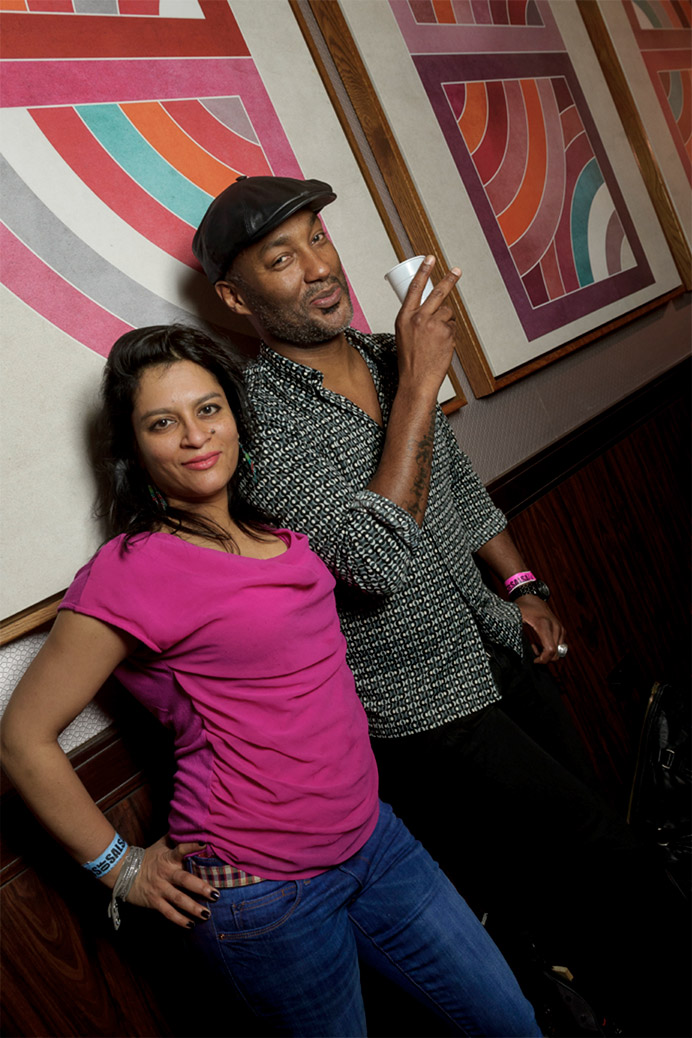
Photo courtesy Valentin Behringer
Moving Group #2: Kaizen workshop with Kwenda Lima and live drumming with Yahael Camara-Onono and Marta Badia-Marin
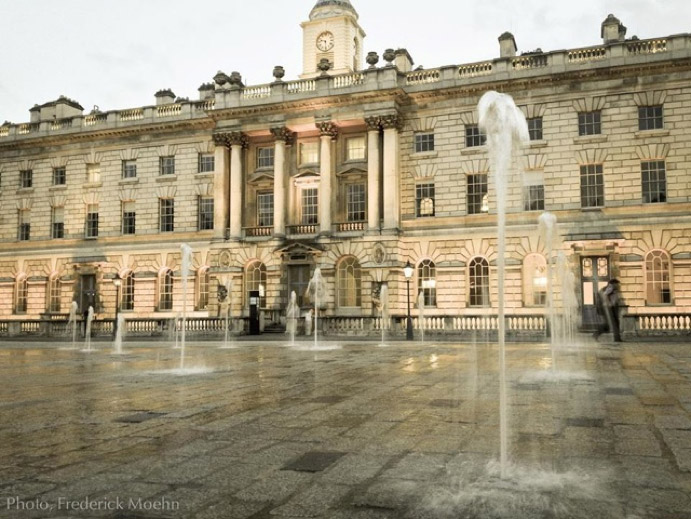
Our second Moving Group brought together our regulars and some welcome additions for a very special event: a kaizen workshop led by Advisory Board member Kwenda Lima.
Kwenda, born in that crossroads of rhythm, Cabo Verde, carries in his body the memories and practices of the myriad dance and music forms of his natal archipelago. Internationally renowned as a dancer and instructor of the Angolan social dance kizomba, he has been additionally developing during the past decade his bold and boundary-crossing project, ‘kaizen dance’.
https://www.facebook.com/KwendaLima.KaizenDance
Kwenda’s kaizen dance is a structured yet improvised use of West African dance techniques in non-narrative, movement-based therapy that makes participants reflect on their immersion in modern capitalist life. Drawing on African kinetic principles of call and response and polyrhythm, as well as Eastern philosophical cornerstones of detachment and meditation, Kaizen instigates a mind-body connection that balances the asceticism and individualism of Indic thought with West African spirituality’s intimate relationship with communal, percussion-led movement. Each workshop tailors these raw materials to suit the abilities and size of the group present. Through a unique combination of intuition and analytical intelligence, Kwenda is able to reach out to the group no matter what the precise conditions are: the dimensions of the room, languages shared (or not), and the number of participants.
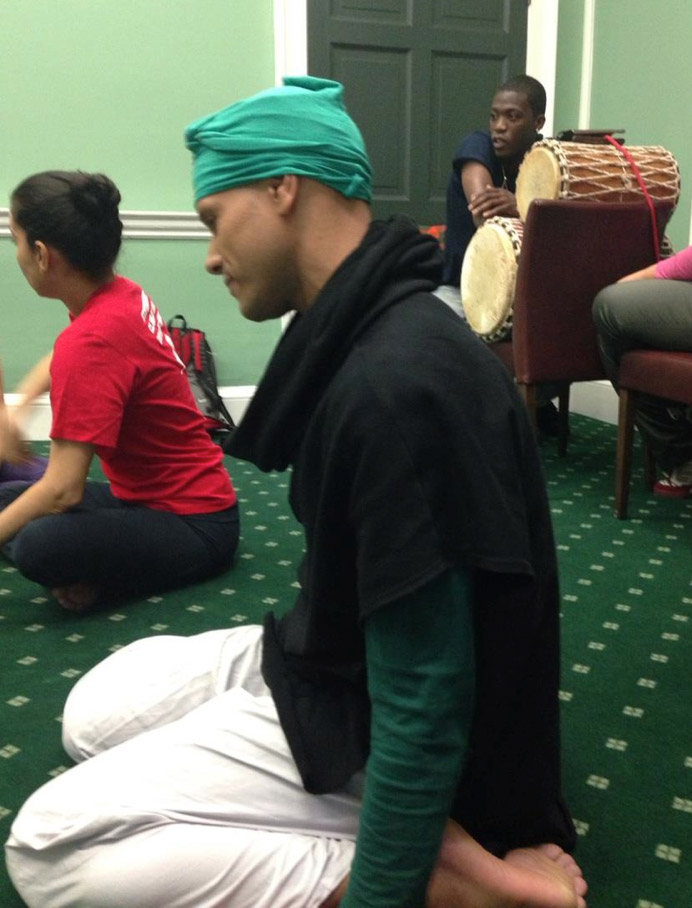
He certainly rose admirably to the challenges presented by the Moving Group in Somerset House: a group of individuals who are trained to think about and analyse movement, only too aware of our complicities and collusions with capitalism, patriarchy and modernity; a room that turned out to be smaller than anticipated; and the presence of two drummers on the West African dunun whom he was meeting for the first time. In addition, a group of law professors were holding a meeting down the corridor and we were warned that they could find themselves disturbed by the drumming, which turned out to be louder than the events organizing team at King’s had anticipated….
Nevertheless, once the drumming began, a certain magic took over. An astonishing synchronicity emerged between our dancing and the drums, which was later revealed as being the essence of improvisation and call and response—Kwenda had relayed no instructions to the drummer Yahael, who simply took his cue from Kwenda’s initial steps (this is what Yahael explained later is called ‘marking’ the dancer). As the tempo built up, he and his partner drummer Marta branched into different West African rhythms to suit our movements even as we gave back to them our energies in synergistic gratitude.
As dusk fell, the open windows allowed us spectacular views of the spotlit façade of Somerset House and the shadow percussion of the fountains in the courtyard below. An unexpected, transformative beauty emerged through the surreal combination of the drums, our movements, and this setting, a powerful architectural reminder of Britain’s imperial past. Our workshop morphed into a momentary subversion of what J. M. Coetzee laments in his novel, Waiting for the Barbarians, as ‘the time of history’ written by Empire, a temporality which continues to shape and haunt our present.
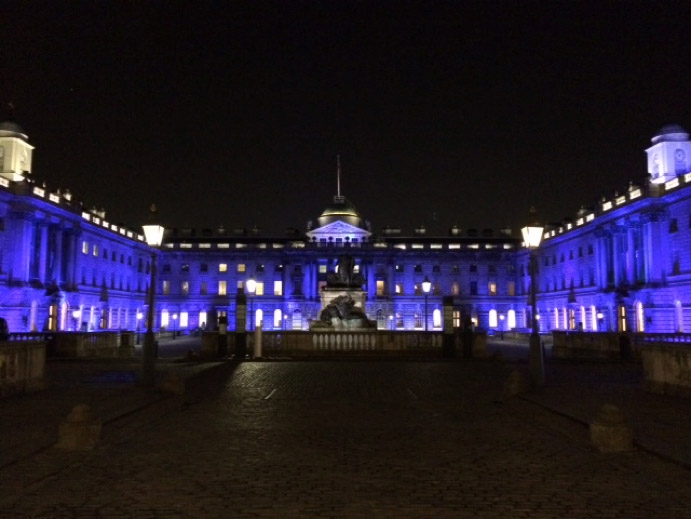
In keeping with his practice, Kwenda stopped movement three times to lead conversations that ranged from the necessity of detachment and woman’s power as birth-giver (two of his signature topics), to issues introduced by the group’s interests— the possibilities and limitations of partner dance, sweat as a signifier of labour and enjoyment, and dance as engineering: the latter point being taken up by Kwenda as a leitmotif through the workshop. Another leitmotif that has remained with us is his suggestive characterization of the ‘empty space’ in which all creative (self) exploration must take place.
While many participants found the conversation breaks initially inexplicable, a continuing chain of responses and reflections via email reveals Kwenda’s interlacing of talk with movement sequences to have been highly productive as stimulus for reflection and rethinking. In effect, the African drum circle, which is the shape our dancing group assumed, has become a kaizen e-circle…. At the same time, the workshop helped extend Kwenda’s practice. It gave him the opportunity to make us work with live drumming— he wants to collaborate again with the drummers— and to work out how to deal with an overly analytical and therefore resistant group of academics who were secretly longing to release their inner rhythms and stop talking.
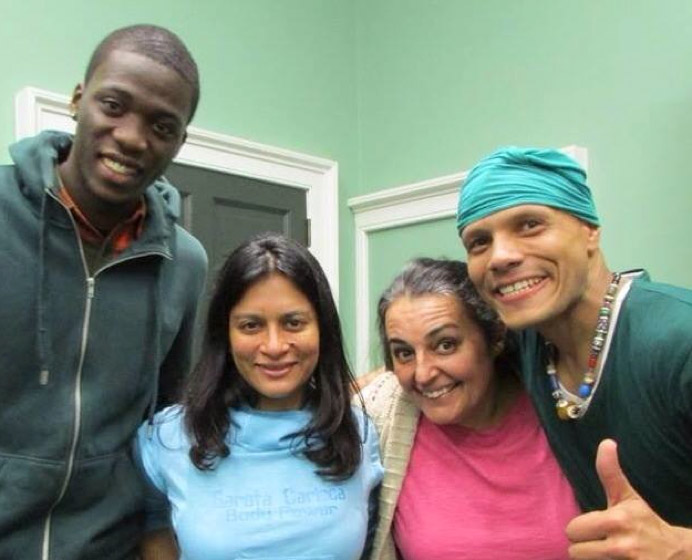
Indeed, the Kaizen workshop re-united the two separate senses of the word ‘articulation’— as the connection of our joints, and as the connection of words into sensible speech— allowing us to view it, in fact, as a process of ‘meta-articulation’. A prolonged dinner at Masala Zone Convent Garden encouraged us to process our thoughts further and the Kaizen e-circle also continues to yield ever-richer insights into the relationship between drumming, dancing, talking, and our individual and collective histories.
We are now working on ways to present the findings of this fascinating experiment to the wider public, in conjunction with Kwenda’s inputs.
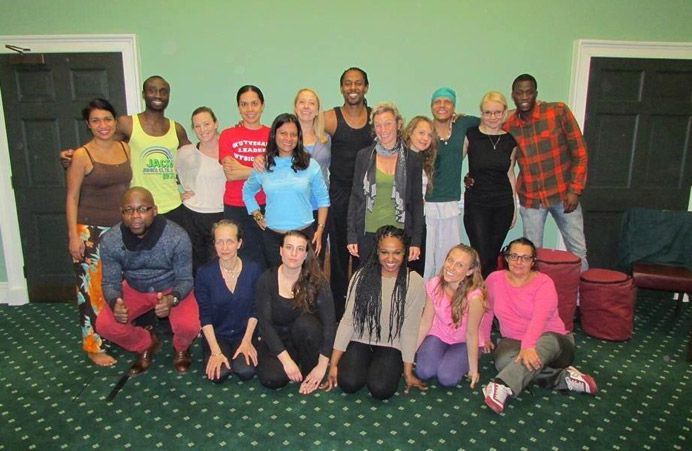
Watch this (not so empty) space!
Moving Group #1: Investigating kuduro in Luanda with Stefanie Alisch
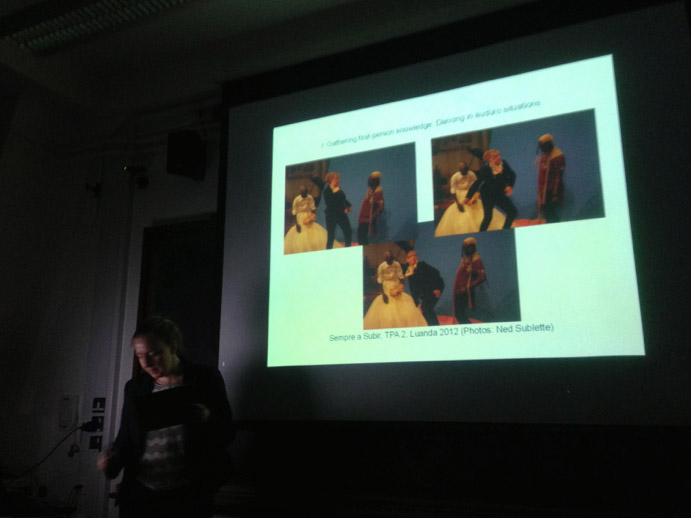
For our first meeting, we were delighted to host our Associated Researcher Stefanie Alisch, musicologist and DJ from Berlin speaking on ‘epistemologies of dance research: investigating kuduro in Luanda’.
Stefanie’s work encompasses research, teaching, publications and creative projects on kuduro, groove, broken beat, music and bodily-performative practices in the Black Altantic, DJ culture, farsi pop, cultural transfer in the Portuguese-speaking realm, and the iconography of music and dance.
About her talk, she said: ‘Kuduro is hard electronic music from Angola complete with accompanying dance moves called toques. Kuduro is a highly visual music culture: dance, sartorial extravagance and posing are instrumental to it. Through naming and kinetic mimesis the toques closely link kuduro music with day-to-day life in the capital Luanda. Toques are chained into rapid acrobatic dance sequences that often transgress social boundaries of space use, violence or morality. An intense impetus called carga (‘electrical charge, load, burden, weight, ammunition’) marks a good kuduro performance.’
In her talk to the Moving Group, Stefanie presented photo and video material of several instances of her own dancing during research trips to Luanda (Angola). Through this material she introduced us to her method of ‘interactive video interview’, where conversation intertwines with dance in front of a video camera.
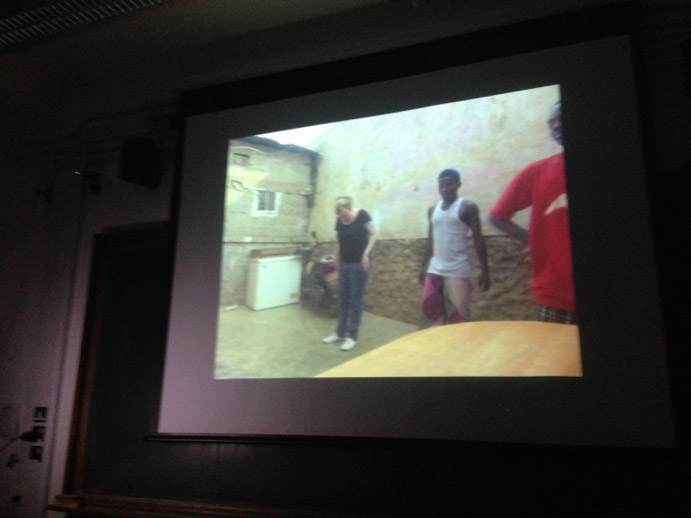
We were treated to videos of Stef rehearsing kuduro dance sequences in quintals (backyards) of Luanda homes, participating in the video-clip ‘Gingubinha’ of Fogo de Deus and Manda Chuva and being called to perform on stage and in front of TV cameras by star kudurista duo Príncipe Ouro Negro (Prince Black Gold) and Presidente Gasolina (President Oil- the names are inspired by the mineral wealth fuelling Angola’s post-war economic boom). Respect!
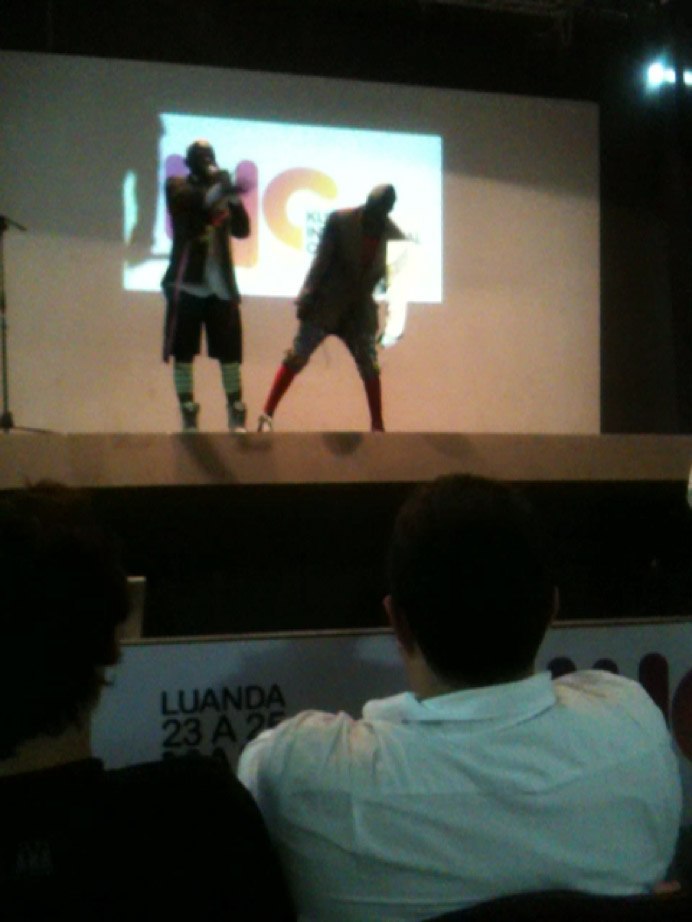
Stefanie’s intent was to spark a group discussion on the epistemologies of dance research, and she certainly succeeded. Based on the collective preparation of Bakka and Karoblis’ essay, ‘Writing a Dance: Epistemology for Dance Research’, the Moving Group worked through certain queries she had about ‘the interactive video interview’ technique, and also brought together the perspectives of different dancer-researchers present to range over a number of questions that we have in common, whether we work with kuduro, salsa or Afro-Brazilian dance forms. This conversation led us to reflections on models of transculturalism, the accessibility of dance knowledge in master-pupil-relationships, and the function of secret knowledge here.
What value is added when the researcher immerses herself in dance situations? We strove to reach beyond the insights that a) the point of learning a dance is not (necessarily only) to be a good dancer but to gradually ask better questions and b) that dancing mobilises corporeal knowledge and triggers memories contained in (other) bodies, which in turn enrich research conversations.
Compatible with Bakka & Karoblis’ (auto-)phenomenological approaches, our Associated Researcher Brigid McClure suggested that the value of auto-ethnography lies in the need to find a way to think about and verbalise one’s own experience on the dance floor. Dancing (and learning to dance) also becomes the way to understand better diverse forms of dance pedagogy- teaching through repetition and discussion; pedagogy that is crystallised, and pedagogy in the making; and the movement between oral and written pedagogical forms.
We arrived at collective reflections of how to productively deal with the fact that each instantiation of a dance differs from its supposed ideal, how linguistic concepts of langue and parole can helps us grapple with this problem, and how to address attempts to standardise or brand dance.
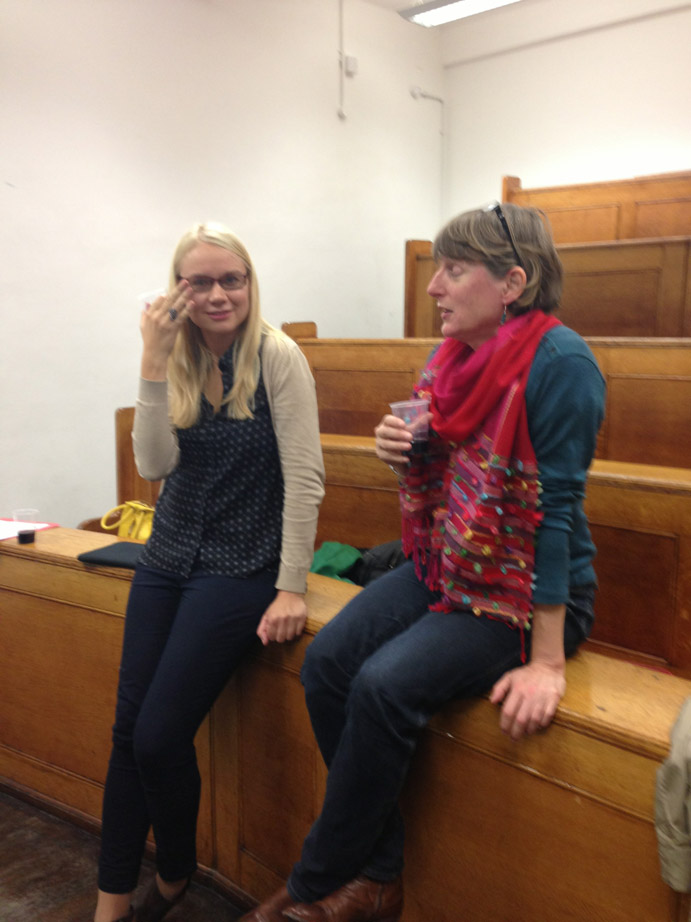
Finally, we concluded that being a dancer is lot more precarious than being a singer. That was hardly going to prevent the group (which included dancers as well as singers) from continuing the evening at Bar Salsa’s legendary Monday night! Over some great tapas, we watched, analysed and joined on the floor the best of London’s salseros and salseras, who come here for their weekly fix of high quality music and dance.
Chutney-Soca-Sega: African and Indian Transoceanic Rhythm Encounters
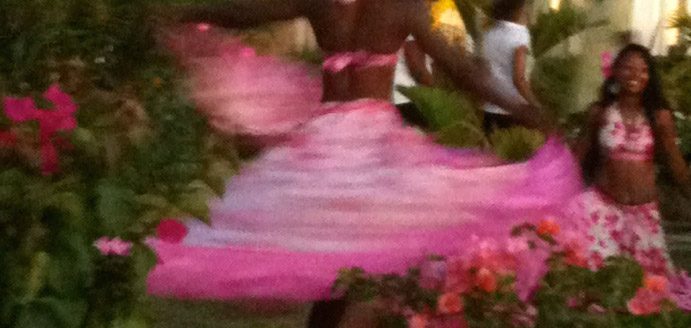
In collaboration with the Tagore Centre for Global Thought, King’s India Institute.
As part of the activities marking the launch of the Modern Moves website, we are proud to host, in collaboration with the Tagore Centre for Global Thought at the King’s India Institute, a truly path-breaking event: a film screening, panel discussion and reception dedicated to discussing rhythm encounters between populations of African and Indian heritage in transoceanic spaces such as the islands of the Caribbean and the Indian Ocean. Developing a particular strand of the discussion around creolization the previous day, this event looks specifically at opening up the notion of creolization to engage the layered presence of Indian- and African-heritage diasporic populations in shared island spaces. Brought together by the global currents of empire and the expanding webs and demands of capitalism, these populations have lived side-by-side and inherited the same bodily histories of sugar and sweat that the Plantation engendered. Why don’t we have more ways to talk about this encounter? What were its cultural consequences?
To prepare the ground for Modern Moves, Ananya has been travelling, since 2010, to sites of Afro-Indian encounter: Trinidad and Tobago, Mauritius, and Suriname. As an ‘Indian from India’ (as opposed to the Indians who have lived in these diasporas for generations) she has always been struck by the unexpected combination of cultural divergences and retentions evident in the language, dress, foodways, and of course music and dance of these places. Her own immersion in Afro-diasporic rhythm cultures made her able to feel how these populations had absorbed ways of moving from their Afro-descendant neighbours. At the same time, postcolonial politics means that overt recognition of these connections is (sadly) often sensitive business. One of the dedicated research strands of Modern Moves, accordingly, is to explore ways in which this shared yet politically fraught story can be told (and moved to). A related aim is to bring to the surface submerged rhythm stories connecting the Indian and the Atlantic Oceans- an interest that resonates with wider worldwide initiatives amongst scholars working across history, musicology and anthropology. The Modern Moves team, along with our Associated Researchers and Advisory Board, includes several people with a foot and an ear in both Indian Ocean and Caribbean worlds, and training in African and Indian rhythm systems. We are in an excellent position to intervene in this work.
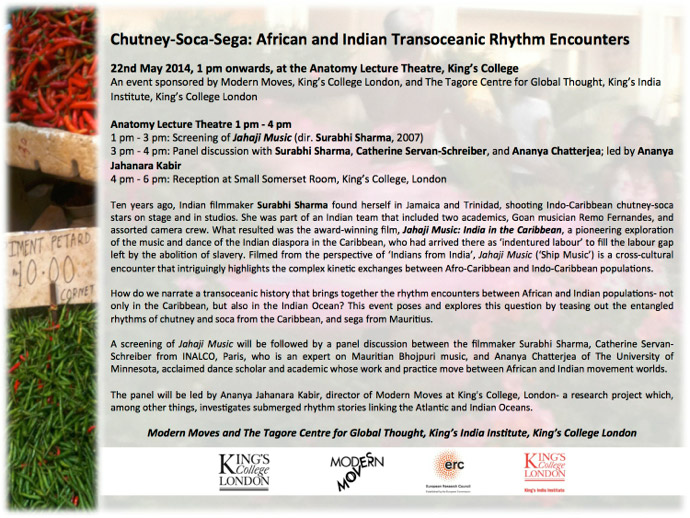
What better way to inaugurate these activities than through collaboration with the Tagore Centre for Global Thought, based at the King’s India Institute? After all, the Nobel laureate, freedom fighter, philosopher and world poet Rabindranath Tagore was himself a world traveller, sailing the Atlantic and the Indian Oceans in voyages that fed his imagination with the rhythms and images of distant lands. Maybe all Tagore needed to do was get down and wine…. Or move to the sounds of sega… We are sure that his spirit would approve of this venture, which we are able to implement thanks to the presence in London of Surabhi Sharma, the director of Jahaji Music (2007), probably the only documentary film made by an ‘Indian from India’ about the rhythm cultures of Indo-Caribbean populations and Ananya Chatterjea, pioneering dance practitioner and academic based in the USA, whose work and inspiration draws equally from Africa, India, and the Caribbean. They will be joined by Modern Moves Advisory Board member, Catherine Servan-Schreiber, who has worked extensively on the interface between Indian and African rhythm cultures in the Indian Ocean. We are excited by this opportunity to kick-start a longer process of writing chutney-soca-sega movement histories!
Vini vini vini vini, la gamat a commencé! (‘Gamat dan kartier’, Nitish Joganah)
Watch the trailer of Jahaji Music here:
Creolizing dance in a global age: A Symposium celebrating creolization as a change maker in the dance world
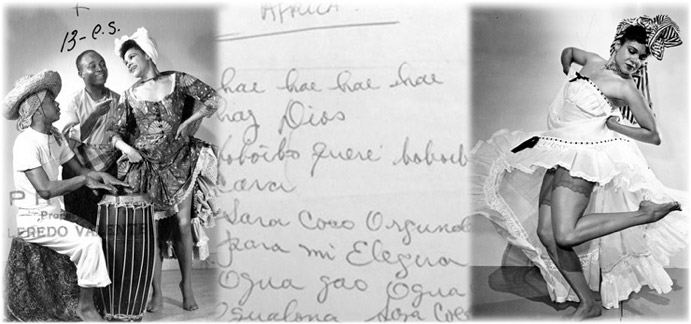
A Cultural Institute at King’s project in collaboration with Modern Moves at the Department of English and Serendipity Dance.
In April 2013, The Cultural Institute at King’s College London introduced Ananya Kabir to Serendipity’s Pawlet Brookes, as part of its efforts to broker collaborations between academics and cultural producers with similar interests. During this meeting, working together on ‘creolization’ emerged as a viable idea. A year later, we are ready to present to the world our symposium, ‘Creolizing Dance in A Global Age’. Funded by the Cultural Institute and organised by the teams at Modern Moves and Serendipity, this symposium sits as part of Serendipity’s annual Lets Dance International Festival in Leicester as well as the activities around the Modern Moves website launch.
This symposium explores the dynamics of ‘creolization’ as a change maker in the dance world, in order to generate a new vocabulary for engagement, diversity and dance. Going to the heart of the multi-cultural, multi-lingual Caribbean, Creolizing Dance brings together for the first time in Britain a constellation of dancers, cultural producers and academics from North America and the Caribbean: L’Antoinette Stines, Artistic Director of L’Acadco: A United Caribbean Dance Force; Patrick Parson, Artistic Director of Ballet Creole; Gladys M. Francis from Georgia State University; Soukaina Edom from Guadeloupe and Zimbabwe, Hilary Brown, programme manager for Culture and Community Development at CARICOM. Also speaking are Roshini Kempadoo, UEL, Ananya Kabir, as Director of Modern Moves, King’s College, and Pawlet Brookes, Artistic Director of Serendipity.
The conference will examine the meaning, relevance, impact and potential of ‘Creolizing Dance’: dance that creolizes, and the creolizing of dance. Through a unique combination of practice and conversation between academics and dancers, of talking and movement, it will reflect on and reveal the spectrum of inter-racial, inter-ethnic, and sometimes paradoxical collaborations and affiliations embodied within the dynamics of Caribbean dance. As the images here testify, we are inspired by the towering figure of Katherine Dunham, African American anthropologist and dancer who, half a century before the ‘Black Atlantic’ became scholarly currency, was using dance as a spiritual, historical and cultural connector to re-assemble the fragments of the African diaspora in the new world.
To speak usefully about connections, we need to be connected with each other. Ananya’s guiding principle, honed during a decade of curatorial work within academia, is to create spaces and conditions where academics and cultural producers can genuinely learn from each other. True exchange of knowledge and expertise can only happen when people are relaxed and feel comfortable in their own skins, and when the hierarchies implicit in traditional academic formats are abandoned. The symposium provided her with a fruitful opportunity to implement and take further this principle. One of the most interesting exercises for the Modern Moves team was to curate thematically appropriate conversation pairs of academics with dance practitioners identified by Serendipity. This format will surely initiate cutting-edge academic debates on creolization processes in the Americas and the Indian Ocean, and dance practice that highlights their continuation in the multicultural present.
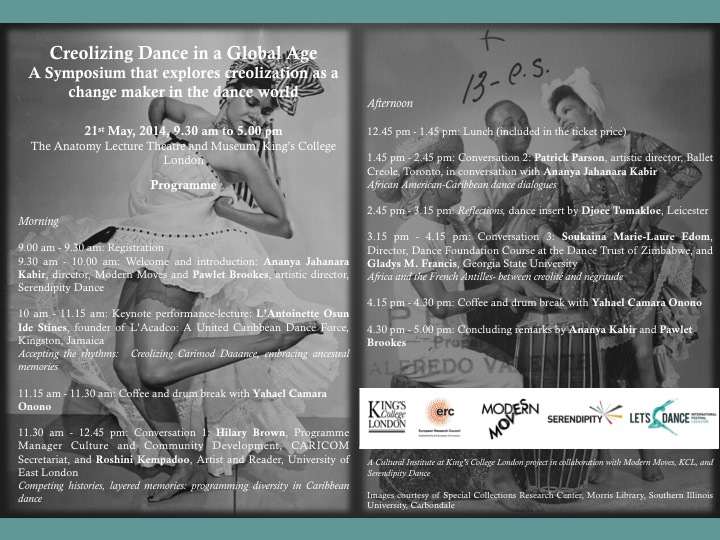
Our symposium is movement-led. The problem with academic events is that we sit down for long periods without movement: hence our programme includes ‘drum breaks.’ What could happen if we had live drumming during the coffee breaks? With a room full of trained dancers, anything, really! Yahael Camara-Onono, drummer for the Modern Moves kaizen workshop, returns again to participate in this experiment. Also, path-breaking dance interventions punctuate the unique curated conversations- with the keynote lecture-demonstration by L’Antoinette Stines combining dance and scholarship to tell us more about ‘daaance’ (we can’t wait to know more!). In these ways, ‘Creolizing Dance’ will showcase and enact ‘black dance’ as comprised of multiple cultural encounters between different heritage groups that have taken place historically in Plantation spaces where Indians, Africans, Chinese and Europeans, all uprooted through the processes of Empire, exchanged music, dance and embodied expression in the daily task of survival. Eschewing a narrow politics of identity, we will instead celebrate an embodied and kinetic awareness of histories of encounter.
As they say in the Caribbean, Axé! Ache pa’ ti!
O Encontro LusoAfricano: Workshop on Angolan Couple Dances
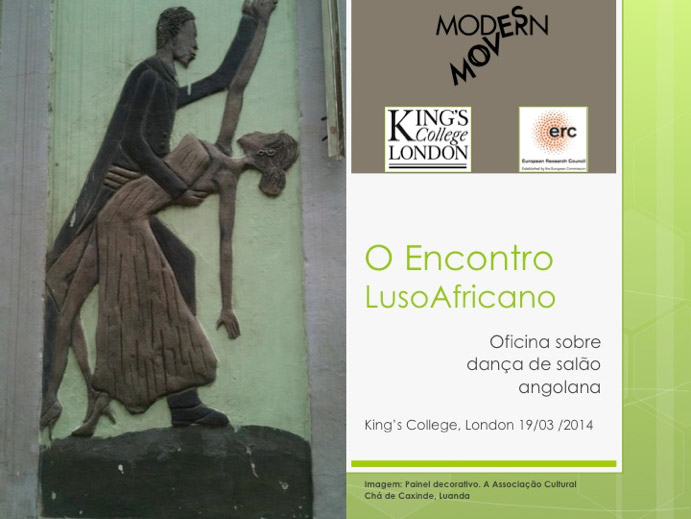
During the past decade, transnational dance floors for Afro-Latin social dances in couple hold (mainly salsa, but also bachata and merengue) have steadily been infiltrated and even, some would claim, superseded by couple dances from Angola: kizomba, tarraxinha and semba. As these dances become ever popular, their growing circle of aficionados in Europe, the Americas and Asia find few answers ‘out there’ on the precise history of these genres. Additionally confusing is that the music that kizomba was originally danced to was zouk from the French West Indies. This cross-pollination of music from the Francophone world and dance from Lusophone Africa has further muddled the waters and prevented the emergence of a clear narrative of how the dance evolved.
Realising that conventional archives hold too few keys to unlock this story, Modern Moves has been committed to creating the conditions where the archives of dancers’ memories and practice could be mined in conjunction with the expertise of academics working on music, dance and politics in the Lusophone world. Ananya Kabir started preparing the ground by approaching practitioners of Angolan dance at their classes and workshops at festivals across Europe. The perfect moment to pull it all together arrived with the information that Advisory Board member Marissa Moorman, author of the only English-language academic book to date on popular music and politics in Angola [link to Intonations] was going to be in the UK in March. On the 19th of March 2014, accordingly, Modern Moves hosted a unique event to explore the history and political significance of Angolan couple dances.
Experienced practitioners were invited to London to explore, together with select academics, the conditions in which these dances developed in Angola as well as their sudden global popularity. They included, from Lisbon, Mestre Petchu and Vanessa Carvalo of Ballet Tradicional Kilandukilu, and Kwenda Lima, creator of Kwenda Lima and Kaizen Dance; Ricardo Sousa and Paula Loureiro of AfroLatin Connection, Oporto; Iris de Brito of Studio AfroLatin, London; and Edson Monteiro (Eddy Vents) and Riquita Alta, established teachers in Britain. Also present were academics Marissa Moorman and another Advisory Board member Fred Moehn from the Department of Music at King’s, our Associated Researchers Brenna Daldorph and Chip McClure, and the Modern Moves team members Ananya Kabir, Elina Djebbari, Francesca Negro and Leyneuf Tines.
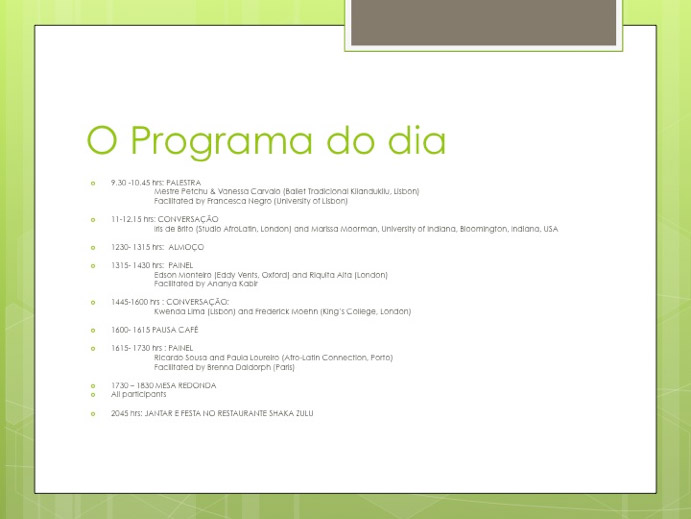
The day commenced with a dense keynote lecture-demonstration by Mestre Petchu and Vanessa, and was followed by conversations between Iris de Brito and Marissa Moorman, Fred Moehn and Kwenda Lima, Edson Monteiro (Eddy Vents) and Riquita Alta, and, finally, between Brenna Daldorph, Ricardo Sousa and Paula Loureiro. Angola, a former Portuguese colony, was decolonized only in 1975 and subsequently plunged into civil war in the shadow of cold war politics. Participants were keen to explore what Angola’s history tells us about decolonisation and postcolonialism in the Portuguese-speaking world. The workshop provided a forum for passionate debate about the overlapping significations of ‘Angola’, ‘Portuguese-speaking Africa’, and ‘Africa’, the revelation of difficult personal histories of war and displacement, as well as the demonstration and sharing of dance steps.
Workshop participants commented that the day was ‘an incredible experience’, ‘a real honour’ and ‘a great opportunity’. All our guests from Portugal agreed that being able to come together in this manner at O Encontro constituted a unique moment in their careers. New pathways to a collaborative historiography of Angolan dance have opened up. If, for our dance practitioners, speaking in an academic setting was different from their usual venues of performance and pedagogy, for the academics in the room it was a refreshing break from the norm to have talks punctuated with dance, laughter and banter. That the entire day’s proceedings were conducted in Portuguese was a shot in the arm for those of us trying to improve our Luso-language skills while for others, it was a chance to relax and communicate in a language that was their daily mode of communication.
Our objective had been to create a space where knowledge could be shared between different stakeholders in the world of Angolan social dance, with a view to eventual collective dissemination. We believe we succeeded. We have recorded over eleven hours of discussion in Portuguese, and our Lusophone expert, Francesca Negro, is now transcribing, translating and compiling a report. In true Modern Moves fashion, the evening ended at Kizomba UK’s weekly kizomba night at Camden’s spectacular African-themed restaurant and club, Shaka Zulu, to which Iris de Brito, the organizer, had invited the whole group. Thanks to Modern Moves, London’s kizomba dancers benefited by the unexpected appearance here of Mestre Petchu and Vanessa, who taught a guest lesson and delighted the crowd with an impromptu demonstration. In between enjoying their class and joining other dancers on the floor, the Encontro participants found themselves comparing notes on the relative deliciousness of crocodile, wildebeest and zebra: a fitting pan-African end to an intense day.
Of course, this being an event around Angola’s contribution to world dance, the concluding sentiment has to be: ‘desliza commigo, piso da pista…’



